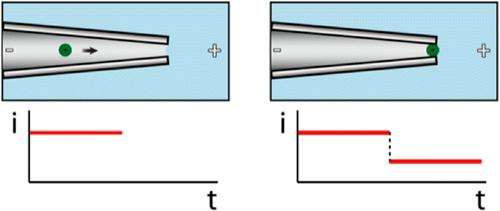Researchers develop new method for detection of specific DNA sequences

(Â鶹ÒùÔº)—The detection of specific DNA sequences is central to the identification of disease-causing pathogens and genetic diseases, as well as other activities. But current detection technologies require amplification by polymerase chain reaction (PCR), fluorescent or enzymatic labels, and expensive instrumentation.
Now, researchers from the UCLA Henry Samueli School of Engineering and Applied Science have developed a device that amplifies the size of a DNA molecule by coupling it to microscale beads that are one-hundredth the size of a human hair. In the presence of the specific DNA sequence to be detected, the beads will produce a large electronic signal that is easily read out by a simple device. This signal is generated because the binding of the specific DNA sequence to the beads gives them a negative charge, attracting them to a small pore, which they block. The electrical measurement of this blockage can be indicated by a simple light-emitting diode in a compact handheld device.
The simplicity and compactness of this new technology may enable low-cost handheld devices for DNA detection without the need for molecular amplification or any additional instrumentation. The method could be used in screening for genetic diseases, food-safety procedures, forensic sciences and other applications.
The research is in the peer-reviewed Journal of the American Chemical Society and will be included in a forthcoming print issue of the journal.
Journal information: Journal of the American Chemical Society
Provided by University of California, Los Angeles

















